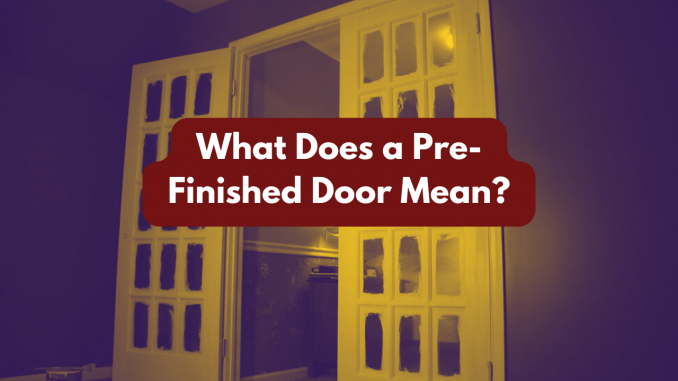
When choosing a new door for your home, you may come across the term ‘pre-finished.’ But what does it mean, and how does it compare to an unfinished door? Understanding the differences can help you make the best choice for your home, whether you’re looking for convenience or customisation. In this post, we’ll explore what a pre-finished door is, the differences between finished and unfinished doors, the potential drawbacks of pre-finished doors, and how you can finish a door yourself, no matter what the size of the door.
What Is a Pre-Finished Door?
A pre-finished door is a door that has already been treated, painted, or stained by the manufacturer before it reaches you. This means that the door is ready to be installed straight away, without the need for additional sanding, staining, or painting. Pre-finished doors come in a variety of finishes, including wood stains, lacquered coatings, and painted surfaces, allowing homeowners to choose a style that matches their interior décor seamlessly.
Pre-finished doors are particularly popular for those who want a hassle-free installation process, as they save time and effort compared to unfinished doors. Since they are treated in a controlled factory environment, they often have a more consistent and durable finish than one applied manually at home.
What Is an Unfinished Door?
An unfinished door, on the other hand, is a raw, untreated door that requires further preparation before it can be installed. This means the homeowner or contractor must sand, paint, stain, or varnish the door to their desired finish before it is ready for use.
Unfinished doors offer greater flexibility in terms of customisation, making them an ideal choice for those who want to match their door perfectly to existing woodwork or have a specific design preference. However, they do require more effort and time, as the finishing process can be labour-intensive and may require multiple coats of paint or stain for a high-quality result.
The Disadvantages of a Pre-Finished Door
While pre-finished doors offer convenience and consistency, they also come with some disadvantages. One of the main drawbacks is the limited choice of finishes. Since the door comes pre-treated from the manufacturer, you are restricted to the colours and stains available, which may not perfectly match your home’s interior.
Another downside is that any damage to a pre-finished door can be more difficult to repair. If the door gets scratched or chipped, matching the original factory-applied finish can be challenging, often requiring professional refinishing or complete replacement.
Additionally, pre-finished doors tend to be more expensive than their unfinished counterparts. The additional cost covers the professional finishing process, but if you’re on a tight budget and willing to put in the effort, an unfinished door may be a more cost-effective option.
How Do You Finish a Door?
If you opt for an unfinished door, finishing it yourself can be a rewarding project. The process involves several steps to ensure a smooth and durable finish:
- Preparation – Sand the door lightly to remove any rough spots or imperfections. Wipe it down with a damp cloth to remove dust.
- Priming (if painting) – Apply a wood primer to help the paint adhere better and create a smooth base. Allow it to dry completely.
- Staining or Painting – If staining, apply a wood stain evenly with a brush or cloth, following the grain of the wood. If painting, apply thin, even coats using a high-quality paint. Allow each coat to dry before applying the next.
- Sealing – Finish with a protective sealant, such as a clear varnish or lacquer, to enhance durability and protect against moisture and wear.
- Drying and Curing – Let the door dry fully before installation to prevent smudging or imperfections in the finish.
A pre-finished door offers a ready-made, high-quality finish that simplifies installation, but it may limit your customisation options and be more expensive. Unfinished doors, while requiring more effort, provide the flexibility to match your exact style preferences. If you’re looking for a quick and hassle-free option, a pre-finished door may be the right choice. However, if you enjoy DIY projects and want a custom look, finishing an unfinished door yourself can be a great alternative.

Leave a Reply